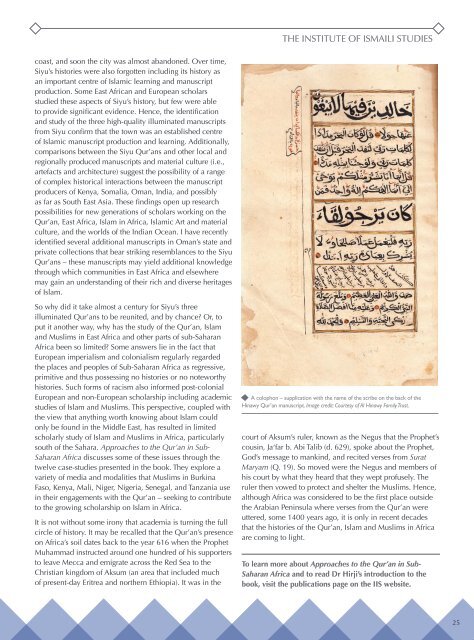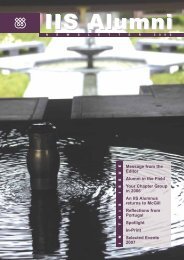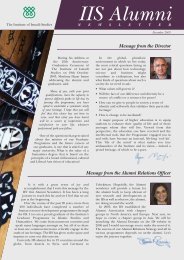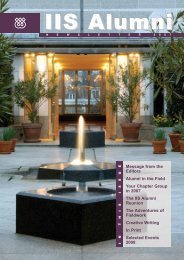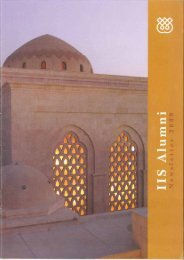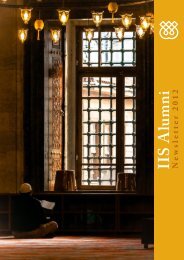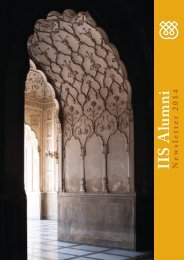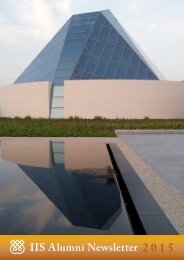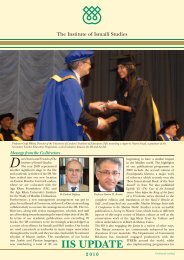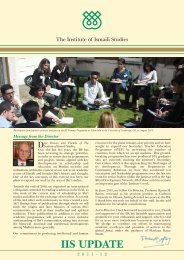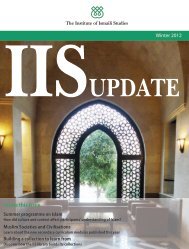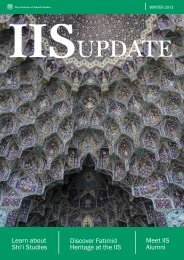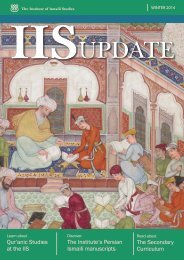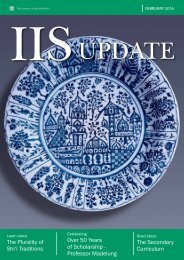Create successful ePaper yourself
Turn your PDF publications into a flip-book with our unique Google optimized e-Paper software.
THE INSTITUTE OF ISMAILI STUDIES<br />
coast, and soon the city was almost abandoned. Over time,<br />
Siyu’s histories were also forgotten including its history as<br />
an important centre of Islamic learning and manuscript<br />
production. Some East African and European scholars<br />
studied these aspects of Siyu’s history, but few were able<br />
to provide significant evidence. Hence, the identification<br />
and study of the three high-quality illuminated manuscripts<br />
from Siyu confirm that the town was an established centre<br />
of Islamic manuscript production and learning. Additionally,<br />
comparisons between the Siyu Qur’ans and other local and<br />
regionally produced manuscripts and material culture (i.e.,<br />
artefacts and architecture) suggest the possibility of a range<br />
of complex historical interactions between the manuscript<br />
producers of Kenya, Somalia, Oman, India, and possibly<br />
as far as South East Asia. These findings open up research<br />
possibilities for new generations of scholars working on the<br />
Qur’an, East Africa, Islam in Africa, Islamic Art and material<br />
culture, and the worlds of the Indian Ocean. I have recently<br />
identified several additional manuscripts in Oman’s state and<br />
private collections that bear striking resemblances to the Siyu<br />
Qur’ans – these manuscripts may yield additional knowledge<br />
through which communities in East Africa and elsewhere<br />
may gain an understanding of their rich and diverse heritages<br />
of Islam.<br />
So why did it take almost a century for Siyu’s three<br />
illuminated Qur’ans to be reunited, and by chance? Or, to<br />
put it another way, why has the study of the Qur’an, Islam<br />
and Muslims in East Africa and other parts of sub-Saharan<br />
Africa been so limited? Some answers lie in the fact that<br />
European imperialism and colonialism regularly regarded<br />
the places and peoples of Sub-Saharan Africa as regressive,<br />
primitive and thus possessing no histories or no noteworthy<br />
histories. Such forms of racism also informed post-colonial<br />
European and non-European scholarship including academic<br />
studies of Islam and Muslims. This perspective, coupled with<br />
the view that anything worth knowing about Islam could<br />
only be found in the Middle East, has resulted in limited<br />
scholarly study of Islam and Muslims in Africa, particularly<br />
south of the Sahara. Approaches to the Qur’an in Sub-<br />
Saharan Africa discusses some of these issues through the<br />
twelve case-studies presented in the book. They explore a<br />
variety of media and modalities that Muslims in Burkina<br />
Faso, Kenya, Mali, Niger, Nigeria, Senegal, and Tanzania use<br />
in their engagements with the Qur’an – seeking to contribute<br />
to the growing scholarship on Islam in Africa.<br />
It is not without some irony that academia is turning the full<br />
circle of history. It may be recalled that the Qur’an’s presence<br />
on Africa’s soil dates back to the year 616 when the Prophet<br />
Muhammad instructed around one hundred of his supporters<br />
to leave Mecca and emigrate across the Red Sea to the<br />
Christian kingdom of Aksum (an area that included much<br />
of present-day Eritrea and northern Ethiopia). It was in the<br />
A colophon – supplication with the name of the scribe on the back of the<br />
Hinawy Qur’an manuscript. Image credit: Courtesy of Al Hinawy Family Trust.<br />
court of Aksum’s ruler, known as the Negus that the Prophet’s<br />
cousin, Ja‘far b. Abi Talib (d. 629), spoke about the Prophet,<br />
God’s message to mankind, and recited verses from Surat<br />
Maryam (Q. <strong>19</strong>). So moved were the Negus and members of<br />
his court by what they heard that they wept profusely. The<br />
ruler then vowed to protect and shelter the Muslims. Hence,<br />
although Africa was considered to be the first place outside<br />
the Arabian Peninsula where verses from the Qur’an were<br />
uttered, some 1400 years ago, it is only in recent decades<br />
that the histories of the Qur’an, Islam and Muslims in Africa<br />
are coming to light.<br />
To learn more about Approaches to the Qur’an in Sub-<br />
Saharan Africa and to read Dr Hirji’s introduction to the<br />
book, visit the publications page on the <strong>IIS</strong> website.<br />
25


